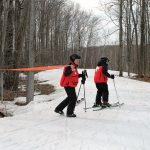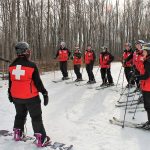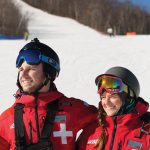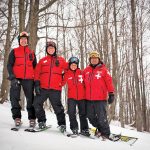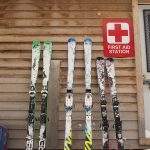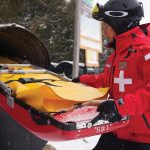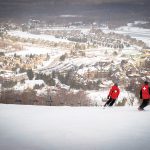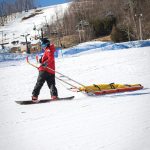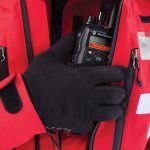Keeping us safe on the hill
by Laurie Stephens
photography by Kristie & Brenden Woods
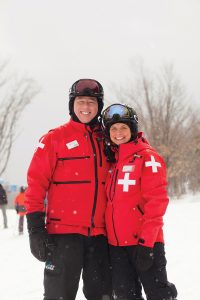
It’s a feeling every downhill skier has experienced: that sickening stab of fear when you catch an edge and lose control.
You fight to stay upright, but it’s a losing battle. You know you’re going down; it’s just a matter of how much it’s going to hurt.
Maybe just your pride will be bruised if your fall results in nothing but a “yard sale” of scattered equipment all over the run (with plenty of witnesses, of course). But sometimes it’s worse.
In my case, I vividly remember clicking out of my skis at a high rate of speed and launching into the air, landing headfirst into a (fortunately) soft pile of snow. I recall hearing a sharp crack in my neck as I hit the snow, then sliding to a stop on my back, my feet facing up the hill.
Stunned, I didn’t move, slowly assessing the state of my body in light of the horrifying crack. I could wiggle my fingers and toes, so I knew that whatever I had done, I had probably not broken my neck. But I lay still all the same, afraid to move and waiting for help.
Before long, one, then two, then a few more ski patrollers arrived on my accident scene. They peppered me with questions, fitted me with a neck brace, strapped me onto a stiff wooden backboard, then transported me down the rest of the hill in a toboggan to a waiting ambulance. In all, from fall to ambulance ride, less than 30 minutes had elapsed.
Thankfully, I walked away with little more than the wind knocked out of me and some common sense knocked in.
I also came away with a full appreciation of Alpine Ski Club’s volunteer ski patrol at its best, and I couldn’t have been more grateful for the care they gave me that day. It’s something they do day-in and day-out, but that day, I felt like I was the most important “casualty” they had ever rescued.
Full disclosure: I am what you might call a ski patrol “groupie.” My spouse has been a patroller for more than 30 years – all of it at Alpine – and through his participation, I have grown to respect and admire patrollers’ professionalism and expertise.
Found at every ski resort on the Escarpment, ski patrollers are a familiar sight in their red jackets with a white cross. They are weekend/weeknight volunteers who, in their day jobs, are paramedics, accountants, firefighters, computer technicians, nurses, business owners, real estate agents, marketing experts, students, retirees, you name it.
What they all have in common is a love for skiing and a passion for helping others.
They encounter everything on the hill: minor cuts and bruises, blown-out knees, broken wrists, concussions, and yes, even life-threatening injuries and deaths from collisions. They are trained in advanced first aid to respond to a wide range of accident scenarios, from treatment of simple injuries on the hill to “load-and-go” situations where the severity of the injuries requires quick transport to a waiting ambulance.
In exchange for volunteering, patrollers get to ski for free. Many ski resorts also offer perks for family members in recognition of the patrollers’ commitment. “It’s a great service we offer,” says Don Rivers, executive director of the Canadian Ski Patrol’s Central Zone. “The value the resorts get is high-end first-aid skills that are specific to winter sport, tending to the patrons of any given club.”
Bill Williams, general manager at Alpine Ski Club for 33 years, says over that time he’s seen patrollers evolve from being first aiders to partners in overall safety, keeping current with various levels of first responder training.
“Many of the Alpine patrol have volunteered at the club for decades,” he says. “With such a dedicated, well-trained and experienced team, there is certainly a level of confidence amongst the club members and staff knowing that accidents or incidents are well looked after.”
Alpine is just one of a number of private clubs in Southern Georgian Bay, including Craigleith, Osler Bluff, Georgian Peaks, Devil’s Glen and Beaver Valley ski clubs. All of these have rosters of patrollers commensurate in size to the skiable terrain and number of daily visitors, ranging from 35 patrollers to 100.
Most of the patrollers in the Blue Mountain area are members of the Canadian Ski Patrol (CSP), a national organization that was founded by Dr. Douglas Firth, an osteopath, in 1941. It now boasts about 4,500 members Canada-wide, 600 of those in the CSP’s Central Zone, which includes the Blue Mountain-area resorts and clubs.
The CSP welcomes anyone 18 or older who has strong intermediate skills as an alpine skier or boarder or Nordic skier.
Blue Mountain, a public ski resort with the distinction of being the second-busiest in Canada, behind Whistler-Blackcomb, re-introduced CSP patrollers to its hills last year after a five-year absence, and the resort now operates with both CSP patrollers and those who are trained through the resort’s own certified training system, which uses the Canadian Red Cross first-aid standards and procedures.
Training through the CSP involves annual recertification of returning patrollers, comprising a written test, a practical first-aid exam and CPR recertification, all in the fall. In addition, patrols do “continuous learning” over the course of the ski season, practising on-hill skills with resort-specific training on resort-specific equipment. In all, 16 hours of training goes into annual recertification.
New patrollers just joining the system start with 56 hours of classroom training – delivered over a few weeks – to learn the basic skills and first-aid material before taking the exams.
Once patrollers are certified, each resort expects them to patrol for a certain number of ski days, from lift opening to close, through snow or shine, in exchange for skiing for free.
The training and time commitment is significant, especially compared to other volunteer activities, but for good reason, says Rivers. “It’s not just a 16-hour training program in the workplace where they’re doing lumps, bumps and bruises and cuts,” he explains. “When you hit an unmovable object, it is going to be far more traumatic.”
Alpine Ski Club’s ski patrol is like others on our section of the Niagara Escarpment: a diverse group of individuals who share a love of skiing and helping others. It is headed by Rick Goldenhar, a long-time patroller who recently retired as a locomotive engineer and safety instructor from CN Rail.
“The one big thing about patrolling is that it makes you get up early to go skiing; you get first tracks in the morning and that’s always exciting, especially on a beautiful, snowy day where the air is crisp,” he says of the job’s perks. “If I don’t have the enthusiasm when I get out of bed, once I get there, people pump me up and get me going.”
Goldenhar says his most difficult task as patrol leader is managing and scheduling 40 people to make sure their commitment to Alpine’s management is fulfilled. But that task is made easier by the people on his patrol.
“People are always stepping up,” he notes. “Once they’re at the hill, everybody is committed to do what they need to do to keep the hill safe.”
Williams says the Alpine ski patrol plays a pivotal role at the club, supporting the safety of club members and guests above and beyond providing professional first aid for people both on and off the hill.
Their presence on the hill creates a perception of safety for everyone at the club, he says, and they also ensure an overall safe on-hill experience by conducting opening and closing sweeps of the runs, monitoring traffic flow and congestion at events like ski races, and always looking for hazards or issues that could result in an unsafe environment.
Williams says Alpine’s patrollers possess many qualities that bring value to the resort’s members and guests, “but passionate would be the one word that likely sums it up the best. It is their passion that leads to their being enthusiastic, committed, knowledgeable and respected.”
Blue Mountain is typically much busier than the private resorts, given its size and skiable terrain. It boasts 43 runs over 365 acres, and sends thousands of skiers up its 11 lifts each hour during the peak ski months.
Murray Frankcom, vice president of mountain operations at Blue Mountain Resort, says the patrollers at Blue know the mountain well; in addition to their winter commitment, many also patrol Blue’s bike and hiking trails in the summer months.
They are true “ambassadors,” he adds, supporting guests by giving directions, make suggestions about the resort’s offerings and providing skiing tips to those who are steadily working their way down a run or simply looking to improve their technique.
“The ski patrol team is well prepared and very efficient when it comes to on-hill incidents, but they also support many other safety aspects at the resort,” says Frankcom. “One of the programs they promote is Easy on the Edges, which is an awareness program that promotes staying at safe speeds and skiing clear of the treeline.”
Skier education is one of the draws for Jen Scholte, who, along with her husband Mike, is a realtor in the area. The couple, both 46, have been patrolling off and on at Blue Mountain for the last 12 years, Jen as a volunteer and Mike for the past three years as a winter paid patroller.
“People find themselves at the top of a run, look down and realize they don’t actually have the skills to be able to make it to the bottom safely,” says Jen, who is also a ski instructor, of a typical scenario she encounters while patrolling the hill. “I like being able to provide an element of education and some direction so that Blue Mountain continues to offer a safe and fun environment for everyone. For me, that’s why I enjoy patrolling.”
Mike is unique amongst patrollers: many years ago, he lost his arm in an accident, presenting him with certain challenges when it came to ski patrolling.
Working with a “very supportive” Blue Mountain safety team and the Red Cross training system, he was able to make adaptations to first-aid equipment, such as developing a strap system that helps him safely transport a loaded toboggan down the hill with one arm. The adaptations, and plenty of practice, have literally paid off: he is on the resort’s payroll as a professional patroller three nights a week.
Mike’s primary motivation for ski patrolling is tending to people who have found themselves in a frightening situation and need assistance.
“I’ve had so many incidents on the mountain over the years, and in almost every case, the person looks up to me and you can see it in their eyes that they’re really glad you’re here,” he says. “That’s so fulfilling to me because it’s my way of giving back.” One of the reasons the Scholtes ski at Blue Mountain is the resort’s night skiing, which allows them to tend to their real estate clients during the day and on weekends. They make a point of patrolling one night a week together, calling it their “date night.”
Both enjoy the camaraderie of the Blue Mountain ski patrol, a tight-knit group that often gets together for meals or a drink after a shift.
“Patrolling is a great way for us to connect with the ‘locals’ in our community,” says Jen. “It’s fun to ski a few runs with our friends and clients who we run into when we’re on the hill.”
In fact, the social aspects of the patrol are a major reason why patrollers return year after year.
The Alpine team holds an après ski most Saturdays after closing sweep of the hill, with patrollers preparing and sharing sushi, chili, chocolate fondues or Hungarian food. During the off-season, Alpine patrollers reconnect for an annual canoe trip, a day at a high-ropes course and golfing.
When patrollers talk about their teams, they frequently say the patrol is like family. Many a lasting friendship has formed; some have even met their marital match on the hill.
“We are one big team; we work together and we play together,” says Goldenhar, who counts meeting his wife on the Alpine Patrol as one of his patrol highlights. “At the end of the day, we talk about our adventures, and it’s all about skiing. It has nothing to do with work, or what’s going on elsewhere.”
Like all not-for-profit organizations, the CSP is constantly challenged with recruiting new volunteers. Currently, a large proportion of the people who patrol are middle-aged people with kids, says Rivers, and while the number of new recruits coming into the system has been on the rise, there is still a gap. “Our drive is to get younger people, but younger people are a difficult capture.”
In response to this challenge, the CSP has changed its recruitment strategies. One of the largest sources of new patrollers is the annual Toronto Ski Show, where visitors can talk to patrollers at the CSP booth. Rivers says the CSP is now populating the booth with younger people to make volunteering for ski patrol more appealing to younger potential recruits.
Michael Cacho of the Alpine ski patrol is part of that target demographic. The 23-year-old, who is in his second year as a patroller, joined the CSP because he wanted to get more involved in the ski community at an operational level and help create a safer environment on the hills.
Cacho says skiing has always been a passion. He raced when he was younger and was a ski instructor in France, where he became aware of the patrol after one of his students became ill on the mountain and needed assistance.
“This experience made me more aware of a ski patroller’s job and what they do, and I told myself that I really wanted to try to do that later,” he says. “I was attracted to how the ski patroller could handle a high-stress situation. I signed up during my first winter back in Collingwood.”
Like other patrollers, Cacho, too, has come to appreciate the social aspects, calling his fellow Alpine patrollers his “second family” on winter weekends. “They bring many laughs to rainy or gloomy days,” he says.
At an accident scene on the hill, however, patrollers are all business.
When asked about incidents that stand out in his mind, Williams says there have been so many over the years, some with better outcomes than others, that it is hard to frame just one. “What does remain a constant in my mind is the professional way the patrol deals with every incident.”
Some situations involve unique aspects or awkward locations such as streambeds, ditches and treed areas, making first aid, rescue and transport to a triage site or ambulance all the more challenging. In addition to the injured person, in almost every incident, care is also directed to witnesses, family, and in some cases teammates, coaches or professional skiers. Support to these people can be as critical as the first aid given to the injured, he says.
During more than one incident Williams recalls hearing parents comment that they recognized immediately at the scene that they needed to step out of the way because ski patrollers were the right people to provide care to their child.
“That recognition always speaks volumes to me,” he says. “At the end of the day, the hope is that you never have reason to experience the level of service and care Alpine ski patrollers provide, but if you do, you are in the hands of the best people for the job.” ❧
If you’re interested in becoming a ski patroller, go to skipatrol.ca or simply approach a patroller on the hill. Donations to the non-profit Canadian Ski Patrol are also gratefully accepted.







